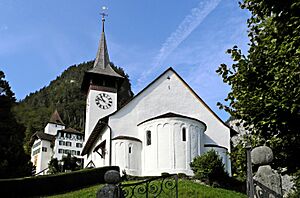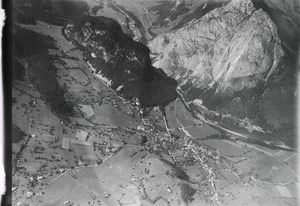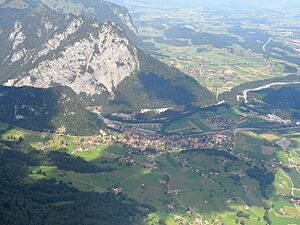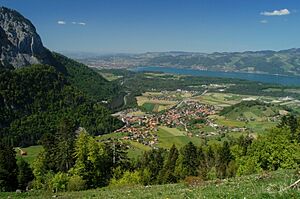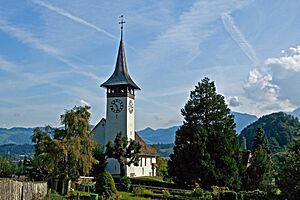Wimmis facts for kids
Quick facts for kids
Wimmis
|
||
|---|---|---|
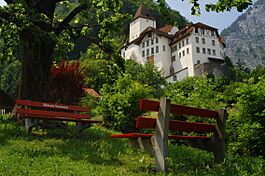
Wimmis castle above the village
|
||
|
||
| Country | Switzerland | |
| Canton | Bern | |
| District | Frutigen-Niedersimmental | |
| Area | ||
| • Total | 22.35 km2 (8.63 sq mi) | |
| Elevation | 629 m (2,064 ft) | |
| Population
(Dec 2020 )
|
||
| • Total | 2,609 | |
| • Density | 116.73/km2 (302.34/sq mi) | |
| Postal code |
3752
|
|
| Surrounded by | Aeschi bei Spiez, Diemtigen, Erlenbach im Simmental, Reichenbach im Kandertal, Reutigen, Spiez | |
Wimmis is a town, also called a municipality, located in the Frutigen-Niedersimmental area in the canton of Bern, Switzerland. It's known for its beautiful castle and its spot at the start of the Simmental valley.
Contents
History of Wimmis
Wimmis was first mentioned in old writings in the year 994, where it was called Windemis. This shows it's a very old place!
Early Settlements and Roman Times
People have lived in the Wimmis area for a very long time.
- Traces of settlements from the Mesolithic (Middle Stone Age) and Bronze Age have been found on hills like Chienberg and Pintel.
- During the Roman era, special items were found, including a bronze statue of Emperor Gordian III.
- In 994, King Otto III gave his lands in Wimmis to a place called Selz Abbey.
The Story of Wimmis Castle
Wimmis Castle, which you can see above the village, was built around the 12th or 13th century.
- It was first owned by powerful families, the Lords of Wimmis or Strättligen.
- Later, by 1260, the Freiherr von Strättligen family owned it.
- The castle and the town below it faced tough times. Bernese troops attacked and burned the town twice, in 1298 and 1334. The castle was also captured in 1334.
- After these wars, the castle and its surrounding lands changed hands many times between different noble families.
- Finally, in 1449, the city of Bern bought the castle and the area around it.
Under Bern's rule, Wimmis Castle became an important center for the Niedersimmental district.
- Over the 17th and 18th centuries, the castle was made bigger and changed into how it looks today.
- In 1708, a big fire destroyed the town around the castle. The town was then moved, and beautiful gardens were planted where it used to be.
- The castle continued to be an important government building for a long time.
- In 2010, the castle was given to the local Wimmis government.
The Village Church
The castle church of St. Martin is also very old.
- It was first mentioned in 1228.
- The church was built in the 10th century on top of an even older church from the 7th or 8th century.
- It was made bigger in the 14th and 15th centuries, and you can still see beautiful murals (wall paintings) from the 15th century inside.
- In 1527, the church and the whole area changed to the Protestant Reformation faith.
Wimmis as a Trading Hub
Wimmis was important because of its location at the start of the Simmental valley.
- It became a key place for trading goods.
- In 1815, a new road was built, which brought even more travelers and trade through Wimmis.
- A village school opened in 1859.
- Later, a railway line was built between 1897 and 1902, connecting Wimmis to other towns. This helped factories come to Wimmis.
- In 1919, a large factory was built that made gunpowder for the Swiss military. Today, it's called Nitrochemie Wimmis and makes special chemicals. It's also the world's largest place for treating paper to make it last longer.
- During the Cold War, the Swiss military kept a store of uranium in Wimmis as part of its research into nuclear energy.
Geography of Wimmis
Wimmis is located between the Simmenfluh and Burgfluh rivers. It's right at the entrance to the beautiful Simmental valley.
- The town's area stretches up the side of the Niesen mountain, all the way to its top, which is about 2,362 meters (7,749 feet) high!
- The municipality includes the main village of Wimmis and smaller areas like Oberdorf, Brodhüsi, Hasli, and Burgholz.
A large part of Wimmis is covered by forests (about 47%). About 29% is used for farming, and a smaller part (about 8%) has buildings and roads.
Wimmis Coat of Arms
The blazon (description) of the Wimmis coat of arms is: Gules a Castle embatteled Argent. This means it shows a silver (Argent) castle with battlements on a red (Gules) background.
People of Wimmis
As of December 2011, Wimmis had a population of 2,463 people.
- Most people in Wimmis (about 96%) speak German as their main language.
- About 8.4% of the people living in Wimmis are from other countries.
- The population has grown by about 3% over the last 10 years.
In 2008, there were slightly more men (51.4%) than women (48.6%) living in Wimmis.
- About 30.9% of the people living in Wimmis in 2000 were born there.
- About 60.2% of the population are adults (20–64 years old), while 22.1% are children and teenagers (0–19 years old).
The chart below shows how the population of Wimmis has changed over many years:

Important Heritage Sites
Wimmis has several important historical places that are protected as heritage sites of national significance. These include:
- The village church of Wimmis.
- The Letzi Spissi fortifications.
- Wimmis Castle.
The entire village of Wimmis is also part of the Inventory of Swiss Heritage Sites, meaning its overall look and history are important.
The Village Church of St. Martin
The village church of St. Martin was built on the site of an even older church.
- It was mentioned in the Strättliger Chronicle in 1228 as one of the twelve churches around Lake Thun.
- The church was rebuilt around the 9th century and later expanded in the 13th, 14th, and 15th centuries.
- Inside, you can see beautiful wall paintings from the 15th century.
- The church became a Reformed church in 1527.
- The pulpit (where the preacher stands) was built in 1672, and the baptismal font (for baptisms) was carved in 1552.
Letzi Spissi Fortifications
The Letzi Spissi fortifications were built about 1 kilometer (0.6 miles) southwest of the castle.
- They were created to help protect the entrance to the Niedersimmental valley.
Economy and Jobs
In 2011, Wimmis had a low unemployment rate of 1.88%. This means most people who wanted to work had jobs.
- In 2008, about 1,081 people worked in Wimmis.
- Many jobs were in the secondary sector (like manufacturing and construction), with 683 people working there.
- The tertiary sector (services like shops, hotels, and healthcare) employed 308 people.
- A smaller number, 90 people, worked in the primary sector (like farming and forestry).
Many people who live in Wimmis also work there.
- In 2000, 409 workers both lived and worked in Wimmis.
- About 15.1% of workers used public transportation to get to their jobs, while 55.6% used a private car.
Religion in Wimmis
According to the 2000 census:
- Most people (about 76.5%) belonged to the Swiss Reformed Church.
- About 9.1% were Roman Catholic.
- Smaller numbers of people belonged to other Christian churches, or were Muslim.
- About 4.75% of the population said they didn't belong to any church.
Transportation
Wimmis is connected by train!
- It is on the Spiez–Zweisimmen line.
- The town has two train stations: Wimmis and Eifeld railway station.
Climate
Wimmis has a climate with a good amount of rain and snow.
- Between 1981 and 2010, Wimmis had rain or snow on about 139 days each year.
- The wettest month is usually July, with an average of 167 mm (6.6 inches) of rain or snow.
- February is the driest month, with about 83 mm (3.3 inches) of precipitation.
Education in Wimmis
Education is important in Wimmis.
- About 60% of the people have finished upper secondary education (like high school).
- About 14% have gone on to higher education at a university or a special college called a Fachhochschule.
The Canton of Bern school system works like this:
- One year of optional Kindergarten.
- Six years of Primary school.
- Three years of required lower Secondary school, where students are grouped by their abilities.
- After that, students can choose more schooling or start an apprenticeship (learning a job while working).
In the 2011-2012 school year, 309 students attended schools in Wimmis.
- There were 39 kindergarten students, 145 primary students, and 125 lower secondary students.
- Wimmis also has a library called Dorfbibliothek Wimmis. In 2008, it had over 6,490 books and other items, and people borrowed more than 16,904 items that year!
Images for kids
See also
 In Spanish: Wimmis para niños
In Spanish: Wimmis para niños





